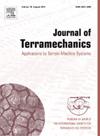A novel soil stress estimation method of wheel-soil interaction using photoelasticity
IF 3.7
3区 工程技术
Q3 ENGINEERING, ENVIRONMENTAL
引用次数: 0
Abstract
This paper proposes a new approach to understanding the wheel-soil interaction, which is an indirect estimation method of soil stress distributions beneath a traveling wheel soil using a photoelastic method. Thus far, several photoelastic methods have been discussed for the wheel-soil terramechanics, but it is difficult for the previous configuration to simulate the dynamic behaviors of natural soil, e.g., compaction, failure, or wheel ruts. Accordingly, achieving both the stress visualization and the dynamic behaviors of soil is a significant challenge to make the photoelastic method more practical. To cope with this challenging issue, we have developed a novel experimental setup consisting of a photoelastic wheel (top layer), soil (middle layer), and a photoelastic plate (bottom layer). By vertically sandwiching the soil between the photoelastic wheel and plate, the soil stresses can be indirectly estimated to satisfy the boundary stress conditions. To achieve this approach, we conducted calibration tests of the photoelastic wheel and plate, and then identified the force vector and contact patch corresponding to the visualized stresses. In this paper, we demonstrate that it is possible to indirectly estimate how the stress propagates and attenuates in the soil by the proposed method.
基于光弹性的轮-土相互作用土应力估算新方法
本文提出了一种新的认识轮土相互作用的方法,即利用光弹性法间接估计轮下土体的应力分布。到目前为止,已经讨论了几种光弹性方法用于车轮-土壤的地形力学,但是以前的配置很难模拟自然土壤的动态行为,例如压实,破坏或车轮车辙。因此,实现应力可视化和土的动力特性是使光弹性方法更加实用的重要挑战。为了应对这一具有挑战性的问题,我们开发了一种新的实验装置,由光弹性轮(顶层),土壤(中间层)和光弹性板(底层)组成。通过将土垂直夹在光弹性轮和板之间,可以间接估计出满足边界应力条件的土应力。为了实现这一方法,我们对光弹性轮和板进行了标定试验,然后识别出与可视化应力相对应的力矢量和接触贴片。在本文中,我们证明了通过提出的方法间接估计应力如何在土壤中传播和衰减是可能的。
本文章由计算机程序翻译,如有差异,请以英文原文为准。
求助全文
约1分钟内获得全文
求助全文
来源期刊

Journal of Terramechanics
工程技术-工程:环境
CiteScore
5.90
自引率
8.30%
发文量
33
审稿时长
15.3 weeks
期刊介绍:
The Journal of Terramechanics is primarily devoted to scientific articles concerned with research, design, and equipment utilization in the field of terramechanics.
The Journal of Terramechanics is the leading international journal serving the multidisciplinary global off-road vehicle and soil working machinery industries, and related user community, governmental agencies and universities.
The Journal of Terramechanics provides a forum for those involved in research, development, design, innovation, testing, application and utilization of off-road vehicles and soil working machinery, and their sub-systems and components. The Journal presents a cross-section of technical papers, reviews, comments and discussions, and serves as a medium for recording recent progress in the field.
 求助内容:
求助内容: 应助结果提醒方式:
应助结果提醒方式:


